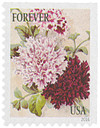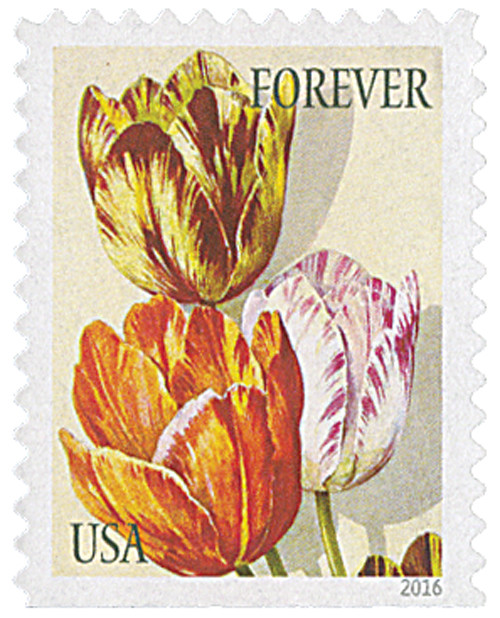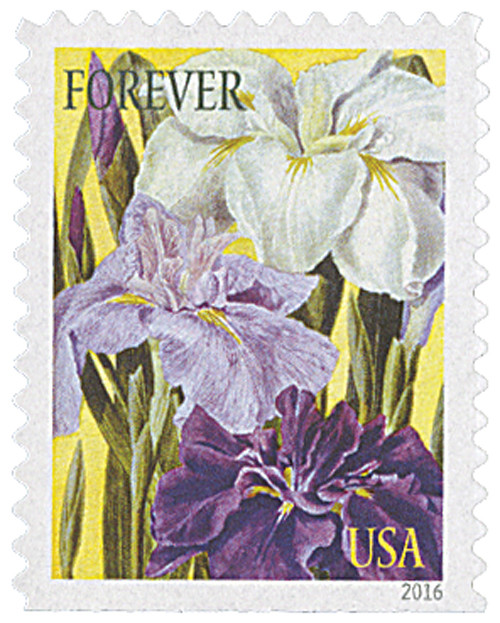
# 5050 - 2016 First-Class Forever Stamp - Botanical Art: Petunias
US #5050
2016 Petunias – Botanical Art
- Celebrates botanical artwork in American nursery catalogs printed between 1891 and 1912
Stamp Category: Definitive
Set: Botanical Art
Value: 49¢ First Class Mail Rate (Forever)
First Day of Issue: January 29, 2016
First Day City: Atlanta, Georgia
Quantity Issued: 60,000,000
Printed by: Ashton Potter
Printing Method: Offset
Format: Booklets of 10 OR Double-sided booklets of 20
Tagging: Nonphosphored type III, block tag applied
Why the stamp was issued: To continue the tradition of printing floral-themed US stamps.
About the stamp design: Pictures petunias from an American nursery catalog printed between 1891 and 1912. The catalog was from The New York Botanical Garden’s Nursery and Seed Catalog Collection.
First Day City: The First Day of Issue Ceremony was held at the American Philatelic Society’s AmeriStamp/Southeastern Stamp Expo. at the Hilton Atlanta in Atlanta, Georgia.
About the Botanical Art set: 10 stamps all picturing different artwork from a 100+ year old American nursery catalog. Species pictured include: corn lilies, tulips, dahlias, stocks, roses, Japanese irises, petunias, and jonquils.
History the stamp represents: Modern botanical gardens evolved from medieval “psychic gardens,” which featured medicinal plants. As explorers and merchants gathered exotic species during their travels, the scientific community developed a system to classify plants. Their method of storing and displaying plants with informative labels caught the public’s interest.
Today, botanical gardens collect, cultivate, and display plants, as well as promote education and conservation. Many have created strong ties with the public in an effort to encourage environmentalism while offsetting their operating costs. The result is a blend of research and recreation that attracts 150 million visitors a year.
About 1,800 botanical gardens exist across the globe, and range from small specialty gardens to sprawling campuses that contain thousands of plants. The diversity among the gardens has created a unique opportunity. A global database of rare and endangered species has been established. It consists of seeds, tissue cultures, and live plants. The goal of the database is to guarantee the survival of these plants in the event of a disaster. If it is ever needed, this conservation effort would make future crops possible and help ensure mankind’s survival.
US #5050
2016 Petunias – Botanical Art
- Celebrates botanical artwork in American nursery catalogs printed between 1891 and 1912
Stamp Category: Definitive
Set: Botanical Art
Value: 49¢ First Class Mail Rate (Forever)
First Day of Issue: January 29, 2016
First Day City: Atlanta, Georgia
Quantity Issued: 60,000,000
Printed by: Ashton Potter
Printing Method: Offset
Format: Booklets of 10 OR Double-sided booklets of 20
Tagging: Nonphosphored type III, block tag applied
Why the stamp was issued: To continue the tradition of printing floral-themed US stamps.
About the stamp design: Pictures petunias from an American nursery catalog printed between 1891 and 1912. The catalog was from The New York Botanical Garden’s Nursery and Seed Catalog Collection.
First Day City: The First Day of Issue Ceremony was held at the American Philatelic Society’s AmeriStamp/Southeastern Stamp Expo. at the Hilton Atlanta in Atlanta, Georgia.
About the Botanical Art set: 10 stamps all picturing different artwork from a 100+ year old American nursery catalog. Species pictured include: corn lilies, tulips, dahlias, stocks, roses, Japanese irises, petunias, and jonquils.
History the stamp represents: Modern botanical gardens evolved from medieval “psychic gardens,” which featured medicinal plants. As explorers and merchants gathered exotic species during their travels, the scientific community developed a system to classify plants. Their method of storing and displaying plants with informative labels caught the public’s interest.
Today, botanical gardens collect, cultivate, and display plants, as well as promote education and conservation. Many have created strong ties with the public in an effort to encourage environmentalism while offsetting their operating costs. The result is a blend of research and recreation that attracts 150 million visitors a year.
About 1,800 botanical gardens exist across the globe, and range from small specialty gardens to sprawling campuses that contain thousands of plants. The diversity among the gardens has created a unique opportunity. A global database of rare and endangered species has been established. It consists of seeds, tissue cultures, and live plants. The goal of the database is to guarantee the survival of these plants in the event of a disaster. If it is ever needed, this conservation effort would make future crops possible and help ensure mankind’s survival.















